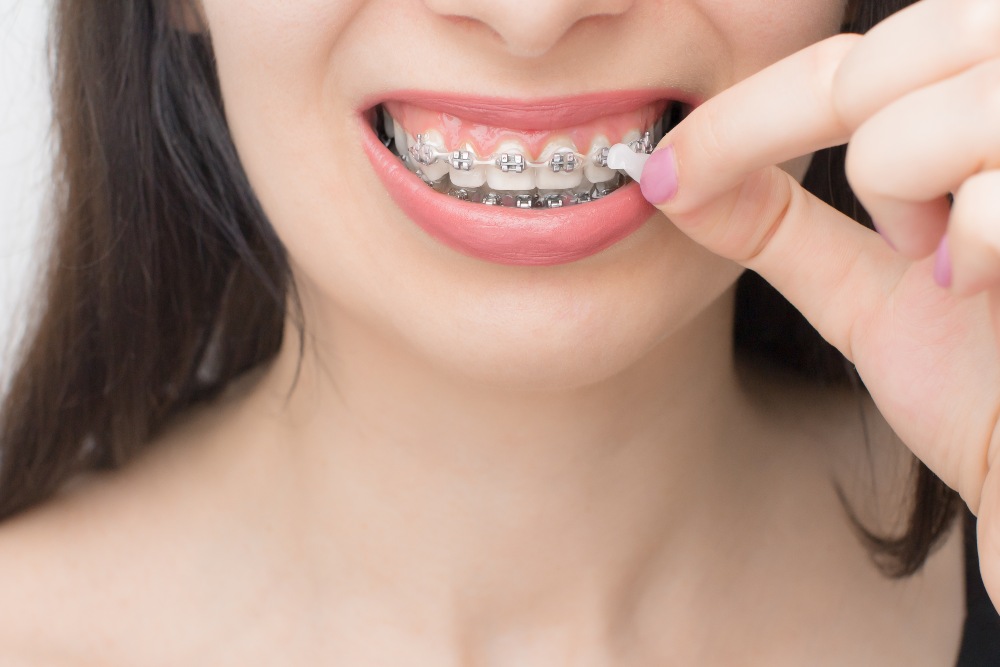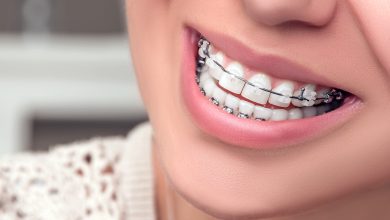What is Dental Wax for Braces?

Dental wax for braces is a soft, pliable material used to provide relief from irritation and discomfort caused by braces. When you have braces, the brackets and wires can sometimes rub against the soft tissues of your mouth, leading to sore spots or ulcers.
Dental wax acts as a protective barrier between the braces and the inside of your mouth, preventing friction and reducing pain. Dental wax is made from a non-toxic, medical-grade material that can be easily molded and applied to the problem areas.
It sticks to the braces, creating a smooth surface and preventing abrasions. Dental wax is transparent or tooth-colored, making it discreet when applied. It is easily manageable and can be reapplied as needed. Whether you’re getting used to new braces or experiencing discomfort from adjustments, dental wax can provide temporary relief, allowing you to continue with your orthodontic treatment comfortably.
The Purpose Of Dental Wax
The purpose of dental wax in braces is to protect the soft tissues from braces wires and brackets, and to reduce discomfort and irritation caused by the braces. Dental wax is a soft and pliable material that can be applied directly onto the braces to create a barrier between the brackets and the lips, cheeks, and tongue. This acts as a cushion, preventing the braces from rubbing against the delicate soft tissues and causing sore spots or ulcers.
By using dental wax, the risk of developing mouth sores is minimized, as it helps to prevent the brackets and wires from causing friction and irritation on the inner cheeks and lips. It also provides relief from any existing discomfort or irritation by creating a smooth surface over the braces, offering a protective layer that allows the mouth to adapt more easily to the braces.

Credit: www.thurmanortho.com
How Dental Wax Works
htmlDental wax for braces serves an important purpose in orthodontic treatment. It functions to create a protective barrier between the components of braces and the soft tissues in the mouth. This barrier helps prevent irritation and discomfort that can be caused by the brackets and wires.
One of the key advantages of dental wax is its moldable nature, which allows it to be easily shaped and fitted over the braces. This makes it convenient to apply and customize according to individual needs. Additionally, the wax securely sticks to the braces and remains in place, providing long-lasting protection and relief.
Another benefit of dental wax is its ability to temporarily alleviate pain and discomfort associated with braces. By covering the sharp or protruding edges of brackets or wires, it reduces friction and minimizes the chances of sores or ulcers forming inside the mouth.
In conclusion, dental wax is a valuable tool in orthodontic treatment, offering a simple yet effective solution to protect the soft tissues of the mouth and provide temporary relief from pain or discomfort caused by braces.
Choosing The Right Dental Wax
htmlConsidering the type of braces you have is crucial in choosing the right dental wax. If you are allergic to certain materials, opt for hypoallergenic wax to ensure that it does not cause any adverse reactions. Additionally, it is important to look for non-toxic and BPA-free options to prioritize your oral health. By selecting a wax that meets these criteria, you can avoid any potential harm or discomfort. Remember to carefully review the product information and labels to ensure that it is suitable for your specific needs. Below is a comparison table highlighting the important factors to consider when choosing dental wax for braces:
| Type of wax | Hypoallergenic | Non-toxic | BPA-free |
|---|---|---|---|
| Option 1 | ✓ | ✓ | ✓ |
| Option 2 | ✓ | ✓ | ✓ |
| Option 3 | ✓ | ✓ | ✓ |
With the table above, you can easily compare different options and make an informed decision based on your individual requirements.
Preparing The Wax
htmlTo effectively prepare the dental wax for braces, start by warming the wax between your hands to soften it. This will make it more pliable and easier to work with. Once the wax is warm, break off a small piece that is large enough to cover the area where your braces are causing irritation or discomfort.
Dental wax is an essential tool for individuals who wear braces as it provides a protective barrier between the metal brackets and wires and the delicate tissues of the mouth. It helps to prevent irritation and soreness caused by the braces rubbing against the cheeks, gums, or lips, providing relief and comfort during the adjustment period.
Applying the dental wax is a simple process. Roll the small piece of wax into a ball and flatten it until it forms a thin layer. Then, place it over the area of irritation, making sure it adheres firmly to the braces. The wax will reduce friction and create a smooth surface, minimizing discomfort and allowing the mouth to heal.
Remember to remove and replace the dental wax regularly, as it may break down or lose its effectiveness over time. With consistent use of dental wax, you can comfortably navigate the braces adjustment phase and maintain good oral health throughout your orthodontic journey.
Applying The Wax
When wearing braces, it is common to experience discomfort and irritation caused by the brackets and wires. Dental wax is a helpful solution to alleviate this discomfort. To apply the wax, make sure to clean the braces thoroughly. Remove any food particles or debris by using a toothbrush and toothpaste. After cleaning, ensure that the brackets and surrounding area are completely dry. Take a small piece of wax and roll it into a ball. Press the wax onto the bracket or wire that is causing irritation. Then, carefully mold the wax to cover any sharp or protruding edges. This will provide a barrier between the braces and the soft tissues of the mouth, reducing friction and discomfort.
Maintaining The Wax
Dental wax is a soft, pliable material commonly used by individuals with braces to provide relief from discomfort caused by brackets and wires. Its main purpose is to create a smooth surface that minimizes friction and irritation. Proper maintenance of the dental wax is crucial to ensure maximum effectiveness.
To maintain the wax, it is important to replace it regularly. As the wax wears out over time, it becomes less effective at providing relief. Removing the wax when eating or brushing your teeth is also essential to prevent it from being accidentally ingested. Additionally, it is necessary to keep the wax clean and free of debris, as accumulation of food particles can affect its adhesive properties.
By following these simple guidelines, individuals with braces can maximize the benefits of dental wax and experience greater comfort throughout their orthodontic treatment.
Be Consistent With Application
When wearing braces, it is common to experience discomfort or irritation caused by the brackets and wires rubbing against the inside of your mouth. This is where dental wax comes in handy. Dental wax is a soft and pliable material that can be applied to the brackets and wires to create a smooth surface and reduce friction. The wax acts as a barrier between the braces and the sensitive tissues in your mouth, providing relief from sore spots and injuries.
To ensure maximum comfort, it is important to be consistent with the application of dental wax. Apply the wax as soon as you feel any discomfort or irritation. It is especially useful during the initial adjustment period when your mouth is getting used to the braces. Additionally, remember to reapply the wax as needed throughout the day to maintain its effectiveness.
Practice Proper Oral Hygiene
Proper oral hygiene is crucial when wearing braces. Brushing and flossing on a regular basis helps to prevent plaque buildup and maintain overall dental health. After meals, it is essential to rinse your mouth to prevent food debris from getting stuck in your braces. However, before brushing or flossing, always remember to remove any dental wax that you may have applied. Dental wax is a soft, pliable material that is used to cover the brackets and wires of braces, providing a protective barrier between the braces and the soft tissues of the mouth. By adhering to good oral hygiene practices and incorporating dental wax as needed, you can ensure a comfortable and healthy orthodontic experience.
Communicate With Your Orthodontist
Dental wax for braces is an effective solution for managing discomfort and irritation caused by braces. It forms a protective barrier between the braces and the soft tissues of the mouth, preventing painful rubbing or sores. If you are experiencing persistent discomfort or irritation, it is important to communicate with your orthodontist. They can provide guidance on the correct application techniques for the wax or suggest alternative solutions to alleviate the discomfort. Following their instructions for proper braces care is crucial to maintain good oral hygiene and ensure the success of your orthodontic treatment. By discussing any issues with your orthodontist and seeking their guidance, you can find relief and ensure a more comfortable braces experience.
Frequently Asked Questions Of What Is Dental Wax For Braces?
How Long Does Dental Wax Last On Braces?
Dental wax on braces typically lasts for a few hours to a couple of days.
Can I Eat With Dental Wax On My Braces?
Yes, you can eat with dental wax on your braces. The wax acts as a protective barrier, but be cautious to avoid getting it in your food.
Why Did My Dentist Give Me Wax For My Braces?
Your dentist gave you wax for your braces to provide relief from discomfort and prevent irritation caused by brackets or wires rubbing against your lips or cheeks. The wax creates a barrier and reduces friction for a more comfortable orthodontic experience.
What Does Wax Do On Braces?
Wax on braces provides a protective barrier between the brackets and your mouth. It helps reduce discomfort and irritation caused by rubbing or poking.
Conclusion
Dental wax for braces is a versatile and essential tool for managing the discomfort and irritation caused by orthodontic appliances. Its unique properties help create a protective barrier and soothe sensitive areas in the mouth. By understanding its purpose and learning how to properly apply it, individuals can experience greater comfort and continue their orthodontic treatment smoothly.
Incorporating dental wax into your oral care routine is a simple yet effective way to alleviate braces-related discomfort. Enjoy a more comfortable orthodontic journey with dental wax!





